|
|
||||
|
By Jo Nova The cost problem is solved (for all the wrong reasons), but it’s still not enoughAround the world, governments are trying to force people to buy electric vehicles because they are nice people who are worried about polar bears. And since drivers out there all believe in climate change, according to all the pollsters, it shouldn’t be a big ask. (Who wouldn’t want to save the Earth?) Supposedly, just 10 years from now, they told us, we wouldn’t be able to buy a new combustion engine car at all. Instead, not only are sales of new EV slowing rapidly, to the point where there is a glut, but as prices fall for used cars customers are not rushing out to pick up the cheaper second hand EVs either. Look at how fast the turnaround in this market has been in the last year — a 25% price premium– gone: Used EVs are now selling for thousands of dollars less, on average, than comparable gas-powered vehicles.Kaya Ginsky, CNBC The difference between the price of a used Tesla Model 3 and BMW 3 Series shows how a “premium” associated with EVs in the initial boom has been erased, according to an analysis from iSeeCars. The decline has been dramatic over the past year. In June 2023, average used EV prices were over 25% higher than used gas car prices, but by May, used EVs were on average 8% lower than the average price for a used gasoline-powered car in U.S. In dollar terms, the gap widened from $265 in February to $2,657 in May, according to an analysis of 2.2 million one to five year-old used cars conducted by iSeeCars. Over the past year, gasoline-powered used vehicle prices have declined between 3-7%, while electric vehicle prices have decreased 30-39%. And all leading indicators are down. Fewer people have plans to buy an EV, and the pool of people who won’t even consider buying one is growing: A Gallup poll of Americans in April found ownership of EVs increasing by 3% annually, but an equal percentage decline in consumers who indicated serious interest in buying an EV, down from 12% to 9%. Overall, 35% of Americans said they might consider buying an EV in the future, down from 43% last year. In Germany, the formerly great industrial empire, EV sales are down 30% compared to this time last year, but sales of petrol engines are up 2% and diesel cars are up 3%. Pierre Gosselin at NoTricksZone tells us the German Federal Motor Transport Authority (KBA) reports a 30.6% fall in registration of new electric cars compared to May a year ago. CO2 emissions of new German cars also rose 3.3%…indicating the green transition has stalled and is reversing. Hat-tip: Blackout News The KBA also adds that 89,498 passenger cars were equipped with a gasoline engine – an increase of 2.1 percent compared to the same month last year. 44,893 new cars were diesel-powered, an increase of 3.2 percent compared to the same month last year. History books will be written about the crazy political EV bubble.
By Jo Nova How much back-up do we need for our 11.5 gigawatt wind system? About 11.4 gigawatts.Wind energy failed on Thursday at what must be close to a record low — with barely 88MW of production from 11,500MW of wind turbines. That’s about 0.7% of total nameplate capacity. With construction costs running at $2 million for every theoretical megawatt of turbine, that’s $20 billion dollars of machinery sitting out there in the fields and forests of Australia producing about as much as two diesel generators. We have 84 industrial wind plants across 5 states of Australia, and the green band below was their total contribution to our national electricity needs on Thursday — put your reading glasses on. Things were even worse in Western Australia, where at the one point that afternoon when I happened to look the state’s total wind generation was minus 11MW. Some wind turbines were drawing a megawatt here and there, perhaps to keep the turbines rolling so they don’t get flat spots on bearings. It was an attack of another climate-denying high pressure cell on Thursday. There was no place in Australia good for wind generation except (maybe) for our research stations in Antarctica. Again, this is now a feature of our weather dependent electricity grid, unless the government can stop these high pressure cells or conquer New Zealand and build a bridge.
But sadly, there is no “building” our way out of this. One thousand more wind-plants won’t keep many lights on, and $100 billion dollars of interconnectors will not connect us to wind power if there is a high pressure cell 5,000 kilometers wide, which there is every two or three weeks. Wind power went from producing 7.2GW in the early hours of Wednesday to 0.09GW by lunchtime Thursday. It was sheer luck it bottomed out at lunchtime on a sunny day when solar panels were at their peak. Seven gigawatts of power disappeared in just 36 hours. If we lost 7 gigawatts of coal plants in a week, we’d never hear the end of it. It’s the minimums that matterPaul McArdle at WattClarity has all the grid data, and provides a spectacular graph of the system-wide peaks and troughs of our wind generators over the last 13 years which he has updated recently to highlight how bad the months of April and May were for wind production in Australia. Click to enlarge this graph to really appreciate the devastating message. While the total wind farm “capacity” has grown massively (the grey columns on the graph), the minimum lowest guaranteed production has not shifted much at all. This is the generation we can rely on, the minimum monthly points are marked in dark green at the bottom. Ten years ago the lowest monthly minimum was practically zero (reaching just 3.7MW one day in July 2014). But since then we’ve built 8,000 MW of extra wind power, at an effective cost of $16 billion, and only bought ourselves effectively two diesel generators worth of reliable electricity? Source: WattClarity If someone asks how much wind can we rely on, the answer is “about one percent”. UPDATE: Paul McArdle at WattClarity confirms that this event occurred, was only 88MW and 0.77% of capacity, and that it was not caused by any human management or curtailment, just by being becalmed. h/t Apoxonbothyourhouses
The deadliest climate question: How many degrees cooler will that be?Ask it now, ask it later, before breakfast and while watching “the news”. Teach the children to ask in kindy. We know the IPCC wildly exaggerates, but pretend they’re right and it still doesn’t make any sense. Richard Lindzen, Will Happer, and William van Wijngaarden took the IPCC at its word and calculate that even if we get to Net Zero by 2050, will only make the world a tiny bit cooler, assuming they’re right (which they’re not) and assuming the rest of the world joins in (which they aren’t). Say we stop all coal, oil and gas, redesign our energy grids, cull the cows, give up our holidays, our cars and ride bikes to work, fill the oceans with windmills, and turn our thermostats down. We spend a quadrillion dollars on a Moonshot to stuff a perfectly good fertilizer in holes underground, and instead of getting to the moon, the world is barely 0.28 degrees C cooler. That’s a half of one lousy Fahrenheit less that it would have been. This ladies and gentlemen is the best case scenario for the global action plan against the 6th mass extinction. This is why 100,000 people in private jets meet each year in Egypt, or Doha, or Azerbaijan. (Or so they say). The whole United States of America could go Net Zero by 2050 and it would, at best, change global temperatures by three one-hundredths of a degree, which we can’t even measure. Rounded to the nearest tenth of a degree that’s a big 0.0°C. And if the Sun does a bit more, then it’s even less. Net Zero Averted Temperature IncreaseR. Lindzen, W. Happer, and W. A. van Wijngaarden Abstract: Using feedback-free estimates of the warming by increased atmospheric carbon dioxide (CO2) and observed rates of increase, we estimate that if the United States (U.S.) eliminated net CO2 emissions by the year 2050, this would avert a warming of 0.0084 ◦C (0.015 ◦F), which is below our ability to accurately measure. If the entire world forced net zero CO2 emissions by the year 2050, a warming of only 0.070 ◦C (0.13 ◦F) would be averted. If one assumes that the warming is a factor of 4 larger because of positive feedbacks, as asserted by the Intergovernmental Panel on Climate Change (IPCC), the warming averted by a net zero U.S. policy would still be very small, 0.034 ◦C (0.061 ◦F). For worldwide net zero emissions by 2050 and the 4-times larger IPCC climate sensitivity, the averted warming would be 0.28 ◦C (0.50 ◦F). Read the entire short paper here at the CO2Coalition: Net Zero Averted Temperature Increase And Christopher Monckton points out the cost to benefit ratio for this $2 Quadrillion dollar project is every billion dollars we spend cools the world by 20 millionths of a degree. So let’s keep all the national science institutions that pointed out what a terrible deal this is for all our nations, and shut down the rest — NOAA, NASA, Hadley, CSIRO, NIWA, BoM, Potsdam, NRC, ARC, and while we’re at it — the ABC, BBC, the CBC because they should have asked better questions, like “how many degrees will that cool us?” UPDATE: And a long time ago Dr David Evans calculated that if Australia got to Net Zero and the IPCC were right, we would “cool” the world by 0.0154°C. We’ve reached a point of Maximal Bureaucratic Psychopathy in ScienceThat’s where committees of committees aim to improve your health by giving one human the ability to kill a billion. In 2015 a scientist at Anthony Fauci’s agency thought it would be neat to mix two Monkeypox strains together to make a nastier one. For no reason anyone can explain, the National Institutes of Health’s Institutional Review Board thought it would be neat too, and approved it. A normal person might worry that doddery Joe Biden has the nuclear codes, but all along, unnamed, unaccountable countless others might have their fingers on equivalent bombs, and they won’t need to input any codes to set off the bombs, just have a bad day. The idea was to mix a deadly but slow strain of monkey pox with a tamer monkey pox strain that spread quickly. This could have created a virus with the “best of both” — an agent with a 15% fatality rate and a reproduction rate of 2.4, which would make it very much “pandemic potential”. (With one infected person infecting 2.4 others, this was a similar rate of spread to the original Wu-Flu, but so much deadlier). So any normal human would know this was a stupid risk to take, but the NIH did it anyway. Worse, they knew it was bad, and they hid the approval for nine years. Even when the investigators from a House Committee came knocking, they concealed the project approval. They now say the experiment was never done, but they can’t point to a single email or memo to show it was stopped. The original approval has only recently been reversed. As long as the festering mess that gave us Covid is not dealt with — it’s just a matter of time before we get the next one. Four years on and no one has been sacked for the lab leak that infected the world, or the cover up that hid the origin. Fauci swears that a biosecurity breach in Wuhan could not possibly have anything to do with his former agency NIAID, but since they hid the monkeypox approval, and told journalists it never happened, then stonewalled and denied it to a congressional committee, Fauci’s assurances are worth about as much as nine years of active deception suggest. Reckless Gain-of-Function experiments with viruses is like letting the local university make nuclear bombs in basements of skyscrapers. Except it’s more dangerous. Is there any reason the NIH should not be razed to the ground? Thanks to David Archibald for sending the story: Fauci’s institute hid mpox gain-of-function plans from Congress and the mediaFor nearly nine years Anthony Fauci’s institute concealed plans to engineer a pandemic capable mpox virus with a case fatality rate of up to 15 percent, congressional investigators revealed in a new report Tuesday. In June 2015, a scientist at the National Institute of Allergy and Infectious Diseases received formal approval from the National Institutes of Health’s Institutional Review Board for experiments expected to engineer an mpox virus with high transmissibility and moderate mortality. NIAID — the institute Fauci oversaw for nearly four decades and which underwrites most federally funded gain-of-function research — concealed the project’s approval from investigators with the House Committee on Energy and Commerce over the course of a 17 month-long investigation. It’s getting hard to tell the difference between an enemy threat and a normal government operation:Mpox, formerly known as monkeypox, caused a public health emergency in the U.S. from August 2022 to February 2023. It is endemic in Africa. The more deadly clade circulates in Central Africa (clade I) while the more transmissible clade circulates in West Africa (clade II). Mpox has infected more than 20,000 people and caused more than 1,000 deaths in the Democratic Republic of Congo, where clade I predominates, according to the Centers for Disease Control and Prevention — though some experts believe that is an undercount of true cases. A strain of the clade II virus drove the American outbreak. The mpox experiment first came to light in a September 2022 article in Science. The gain-of-function project proposed by NIAID virologist Bernard Moss would splice genes conferring high pathogenicity from the clade I virus into the more transmissible clade II virus. The new “chimeric” (combined) virus could have retained up to a 15 percent fatality rate and a 2.4 reproductive number, a measure of transmissibility indicating every sick person could infect up to 2.4 people on average, giving it pandemic potential. When it’s a matter of life and death, why not put a lying agency in charge of checking its own funding? This is what the experts do: “The new [Office of Science and Technology Policy] continues to give funding agencies, like NIAID, primary responsibility for oversight of GOFROC [Gain of Function Research of Concern] and DURC [Dual Use Research of Concern] experiments involving potentially dangerous pathogens,” the committee’s report reads. “In almost any other scientific field or industry, this arrangement would be immediately recognized as a conflict of interest, necessitating independent review and oversight.” They are talking about some of the nastiest plans known to man. DURC or “Dual Use Research of Concern” is the polite way to label a discovery that has a dual purpose, meaning it could be a cure for cancer or a weapon of war. They could just as easily have called it Potential Bioweapons of War, but they don’t want to scare the funders (us). What if researchers were high on the thrill of the discovery-of-a-lifetime and most of the costs and risks (global pandemics) are externalized, and the committees that approved them worked as well as “peer review” does in the rest of government strangled science? What if some of those committees were infiltrated by foreign adversaries? That might actually improve things. The Russians might leak the news of what’s going on in Western labs to the media… The one “good” thing about this story is knowing that the last pandemic could have been so much worse. Mad scientist image by Lisa Yount from Pixabay
By Jo Nova Here we go again. It’s another round of the climate wars in Australia. It’s the issue that never dies, because global weather control is a stupid idea levitating on righteous indignation and a hundred billion dollars. As long as it floats, it’s the Hindenburg of National Energy Policy. It will only end when there’s nothing left to burn. This time, the opposition leader, Peter Dutton, has said what all the grown ups already know — that the 82% renewables target by 2030 that Labor legislated is doomed and we should delay it. Two years after ignition, everyone knows the NetZero rocket is impossible. Renewable investment has ground to a halt, people are not buying EV’s, farmers don’t want the transmission lines, coastal towns don’t want the wind towers, project costs are doubling and tripling, and Florence the borer is still stuck in a short hole that is meant to be a long one. Worse, we’ve already got more solar power than the grid can handle and extra solar power is so useless we’re about to start charging people who carelessly add to the glut at lunchtime. Peter Dutton is sadly still saying we should do “Net Zero by 2050” — which will stop him mocking the whole pagan religion of weather control, but he is offering a real alternative — we can stop banging our heads on the wall for a few years. The government meanwhile is fighting back with their best missives of scorn and damnation. Apparently this will lead to the awful affliction called “pariah status”. The world won’t want to dance with Australia, or something. Or, more likely, Sydney Harbour might drop a few spots on the Green Backpacker Holiday Guide. Like we care. The media leapt to declare hyperbolically that “Dutton is pulling out of the Paris Agreement” because, being globalist junkies themselves, they thought this would be an insult. But instead of being a shocking misstep those headlines may have earned him fans. The EcoWorriers seemed to have forgotten that at the drop of a hat, back in 2018 48% of Australians said they’d be happy to pull out of “Paris”. That was without any discussion at all. Half the country didn’t care less. Imagine if we had a debate now with the cost-of-living-dog chewing on voters ankles? Paris is a sacred totem for believers to dance around. But its almost all theater — China agreed to do nothing, and most nations will miss their targets. Now even the UN admits the world will crash through Paris Agreement goals by a factor of two for 2030. The pimps for Paris can hardly threaten Australians with twice as many cyclones next year, or 20% more floods by 2025. They know, and we know, that the benefits of “Net Zero” are just social approval points on a Leftist dance card. There is no productivity growth, no cheaper electricity, no nicer weather coming our way — at least not for a hundred years (even in theory). So when someone pops the bubble, all they can fire back with are social credit costs not real ones. Dutton will make us “the Global Laughing Stock” they say, lamely. He will risk our membership of the Paris Agreement — the club which we pay for, and which includes practically every nation on Earth — (as if the UN would want to take its claws out of any wealthy donor). As Graham Lloyd remarked: “Peer pressure is the only tool at the UN’s disposal. “ The non-binding compromise at the heart of the Paris Agreement that allowed US president Barack Obama to sign it without seeking the approval of congress makes the Paris Agreement a voluntary affair. .. Put bluntly, if countries were excised from the Paris Agreement for not meeting high expectations, it would be a gathering of none. The Labor Party will find in the next election, like the last “climate election” in 2013, that they have very little material benefit to offer the voters. But no one will believe the “cheaper electricity bill” lie. Labors target is a 43% emissions reduction of our 2005 emissions by 2030. Most of the reduction will come (in their dreams) from being 82% “renewable” for electricity (up from 32% renewable now). Just to put that in perspective, here’s the graph of Australia’s total energy consumption which at the end of 2022 was 85% fossil fueled. To reach this frivolous quest, Australia is supposedly going to install 22,000 solar panels every day and a new wind tower every night, somehow we’ll install 10,000 kilometers of high voltage power lines, and we will find $1.5 trillion spare dollars to pay for it all. The actual “Paris Agreement” Australia signed was to reduce 2005 emissions by 26 to 28% by 2030. It was Labor in 2022 that raised the stakes and legislated the 43% cut, just to impress their friends at Davos or something. So many political careers have died on “climate change” and yet few political commentators seem to realize why. Image by Roy Snyder from Pixabay
By Jo Nova The spell is brokenThirty years of crafting a fantasy narrative was fine while countries floated on a cloud of endless easy money, but those days are over. Counting is still underway in the EU elections, but the Greens appear to have lost around 20 seats, shrinking from 74 seats to 53. In Germany, the Green-stranglehold of Europe, exit polls suggest the Green vote fell from 20.5% to 12%. In a shock, Marine Le Pen’s party in France doubled Macron’s party vote achieving 30% of the vote to his 15%, whereupon Macron called an emergency election, hoping to save a few extra spots in France’s Parliament before the “Far Right” really wakes up. The “Far-Right” of course, being any party which doubts that bicycles can stop storms: Despite 242% of Nobel prize winning experts being certain that life on Earth will be destroyed by 2034*, climate action was not a priority for most Europeans.
Newspaper journalists though have different priorities to most voters. There go those climate ambitions…  The result comes amid a broader shift to the right and a green backlash — or “greenlash” — against policies designed to tackle the climate crisis and protect the environment. Some newspapers don’t just have different priorities, they speak a different language: Who are these parties that deny that we have a climate? Five years ago The Guardian called it a “Quiet Revolution Sweeping Europe” as the Greens went from fringe idealists to “potential kingmakers”. Instead it was a five year reckless experiment that trashed historic industries and threatens a lifestyle that took a thousand years to create. The real Kingmakers in the EU who were panicking about climate change last week, are now suddenly non-committal about inviting the Greens to talks. It was always about power for Ursula Von der Leyen and sadly she is still there. There is still much to do. The wonderful Mark Steyn on the EU elections and the media massaging: Indeed, between [Marine Le Pen’s] triumphant National Rally and M Zemour’s Reconquête (the Reconquest party), what the BBC and even the Telegraph insist on calling the “far right” got just shy of forty per cent of the vote. (M Zemour’s party is for those who think Mme Le Pen is no longer “far right” enough.) In Germany Olaf Scholz saw his party come third, behind the even more “far right” Alternative für Deutschland. Over a million of Scholz’s voters switched to the ooh-ever-so-far-right AfD. So the “far right” are getting a lot nearer: maybe the Telegraph should try holding the telescope the right way round. Instead, the media took consolation in finding the far-right rampage didn’t go quite as far as it might: in the Netherlands, Geert Wilders’ Freedom Party has gone from zero seats to six to emerge as the largest single Dutch party in the European Parliament – but all the experts are agreed that for some reason this is a wee bit of an under-performance. UPDATE: Good news, the young voters are turning away:[Google translated] Greens with massive losses – especially young voters turn awayThe AfD and CDU are particularly popular with young voters. Voting right is not a trend, but rather a matter of self-defence. The Greens are the main losers, as they have become the epitome of philistinism. They get the ridicule of the internet for free. Both parties have lost their magic. Now things are getting even worse for the Greens. The new youth parties are called AfD and CDU. Of all things! Anyone who joins the Junge Union or the Workers’ Party for Germany today is a revolutionary. The middle class is green, or better said: the bourgeoisie. And who is alternative if they are on the side of the philistines? For most young people, however, it is clear that they will not retire at 70, they will not buy a house, and they may not be able to support a family – and if they do, their children will grow up in problem areas, in rural wasteland or in an environment of left-wing indoctrination. Voting right is not a trend, not chic, not a whim. It is pure self-defense.
h/t Willie Soon, Krishna Gans, Old Ozzie, David Wojick, Kim, Stephen Neil. *How many climate experts said Antonio-Guterres Mr-Boiling-Planet was wrong? Far-Right-Bell curve original author unknown. Seen on this tweet.
EV manufacturers are backing away slowly from the Great EV DebacleThe government commanded the EV bubble, but even with billions in subsidies, schemes and advertising the chemistry didn’t obey. Somehow, even with legislation, the right discoveries didn’t discover themselves on cue. VW has decided to use one third of its EV development money to develop a better fuel car instead. Hey, it’s only 60,000 million Euro. VW Will Spend Billions of Its EV Development Budget on Gas EnginesBy: Adrian Padeanu, Motor1.com Of the €180 billion ($196 billion) set aside in 2023 primarily for next-generation EVs, the German brand will now use one-third to continue the development of combustion engines. The announcement comes from Arno Antlitz, the Chief Financial Officer and Chief Operating Officer at the Volkswagen Group. The company intends to spend roughly €60 billion ($65 billion) to “keep our combustion cars competitive.” It’s a stark departure from the previous plan announced in late 2022 to build and sell only electric cars in Europe from 2033. Only a year ago Volkswagon was confident it could build a cheaper EV. But a month ago they reported a 20 percent fall in first quarter profits. Meanwhile Australia joins the EU with footage of “EV Graveyards” collecting at Port MelbourneAustralia remains far behind the rest of the developed world in EV sales but is obviously catching up on the latest trends quickly. Sales have fallen 44%:
And, apparently even those with money to waste don’t want to waste it on an “electric supercar”:Lamborghini Doesn’t Think Electric Supercars will Catch OnBy: Adrian Padeanu, Motor1.com Speaking with Automotive News Europe, Lamborghini’s head honcho Stephan Winkelmann argued electric supercars are “not something that is selling so far.” He went on to mention this genre might never catch on Supercars are for rich folk but Rimac CEO Mate Rimac recently admitted that high-end buyers don’t want electric supercars. It’s why the Nevera is still for sale, despite the hype around it and the limited production run of only 150 cars. The electric hypercar developed in Croatia set no fewer than 23 records last year, but it looks as though wealthy people weren’t impressed enough to sign their names on the dotted line. There is talk now of all kinds of variations of sustainable fuel to run combustion engines on. The CEO of Bugatti has even floated the idea of selling their bespoke customers their very own fuel station as well, so they can generate and fill their sustainable cars at home. Possibly the brag-able-value of owning a sustainable biofuel car that “charges at home” using some wildly expensive combination of solar panels and batteries won’t seem so brag-worthy in a few years time. Who wants to look like the loser who got car advice from a teenage girl? By Jo Nova To solve the increase in global disasters just axe the UNDespite a galactic rise in Headlines of Doom, the world is a safer place than ever. The United Nations however is an absolute danger to our quality of life and our children’s mental health. They’ve shamelessly concocted the myth that disasters are increasing due to “climate change”. NetZeroWatch report on a new paper on natural disasters and find that yearly deaths are down. Somehow satellites, phones, antibiotics, bulldozers and fire trucks are better at saving lives than horse drawn carts and hessian bags. Who would have guessed, apart from everyone? Below the graph of natural disaster events shows a huge increase in the reporting of disasters, at least up until the turn of the century. But there is, if anything, a decline since then. There are three very different trends. But the giant bureaucratic sponge that is the United Nations can shamelessly draw a straight linear trend through this graph and tell the world that disasters are getting worse, even as they are obviously not. In the last twenty years, humans have put out 40% of all the CO2 emissions they’ve ever put out since they lived in caves, but disasters have decreased 20%. It used to be that 20 year trends were enough to launch a new UN committee, but now the only trend-length that matters is the one that goes “up”. Another pair of analysts point out the CRED (Centre on the Epidemiology of Disasters) was only set up in 1973 and the EM-DAT database was only established in 1988. (Ritichie and Rosado). Even the CRED team itself has warned people about reading too much into these trends, yet practically every separate wing of the UN has done exactly that. The FAO said “disaster events have increased from 100 per year in the 1970s to around 400 events per year worldwide in the past 20 years.” The UN Chief said “natural disasters have quadrupled since 1970.” The the UNFCC took his misinformation and repeated it. A few years ago the WMO said “The number of disasters has increased by a factor of five over the 50-year period.” The BBC and The Economist lapped it up. Too many mistakes is never enough. In 2019, the UN Office for Disaster Risk Reduction (UNDRR) opined about the “‘staggering rise in climate-related disasters over the last twenty years’” proving only that lying UN agencies are a bigger threat to the science than the entire fossil fuel industry ever was.
The rise in all of these disasters is mostly because people got better at reporting disasters. Back in 1901 if a cyclone landed in Ecuador, nobody rang up the UN, which didn’t exist, on phones that weren’t installed, to tell them about it. And when global population was five times smaller in 1900 tornados could wander the prairies and sometimes no one would notice. Droughts could strike rivers and unless the fish complained, who would know? Suspiciously geophysical disasters (like earthquakes and volcanoes) have also increased “since 1900” and at about the same rate and with the same “break point” in the trend. Obviously our gas guzzling cars are not causing earthquakes and beef-steak doesn’t set off volcanoes. So the rapid increase in these sorts of disasters in the 1970s and 1980s supports the theory that the rapid rise an artefact of data collection. There’s a lot more detail on that in the paper.
Meanwhile, the relentless good news on global crops continues. If there really were more storms and frosts and devastating floods, you’d think the rice paddies and cornfields of the world would have noticed. Yet here they go again, growing 2 to 4% more grain year after year. Alimonti and Mariani don’t mince their words — the increase is just “better reporting”: We conclude that the patterns observed are largely attributable to progressively better reporting of natural disaster events, with the EM-DAT dataset now regarded as relatively complete since ∼2000. The above result sits in marked contradiction to earlier analyses by two UN bodies (FAO andUNDRR), which predicts an increasing number of natural disasters and impacts in concert with global warming. Our analyses strongly refute this assertion as well as extrapolations published by UNDRR based on this claim. The claim that the increase in disasters registered in EM-DAT in the final part of the twentieth century is mostly, if not completely, caused by better reporting and not by a real events increase, is supported by three independent lines of evidence: (a) several CRED reports (Guha-Sapir et al., 2004; Scheuren et al., 2008; CRED, 2015); (b) best fit analysis that found an important breakpoint and even a change in the trend sign of natural disasters at the beginning of the 21th century, in agreement with what is written and justified in point a; (c) the same trend change and breakpoint for geophysical disasters that have very little, if anything, to do with human activities or global warming. But it’s also “better blindness”. If the BBC, The Economist, and all the other sycophant agents of groupthink and power-mongers asked for “a graph” (with all the data) the facade would fall over in a week. REFERENCESGianluca Alimonti & Luigi Mariani (2024) Is the number of global natural disasters increasing?, Environmental Hazards, vol 23: No 2, 186-202, DOI: Emergency Events Database (EM-DAT) from the Center for Research on the Epidemiology of Disasters (CRED). Hannah Ritchie and Pablo Rosado (2024) – “Is the number of natural disasters increasing?” Published online at OurWorldInData.org. The GWPF helpfully provides a list of references, including their work refuting these claims:
|
||||
|
Copyright © 2024 JoNova - All Rights Reserved |
||||


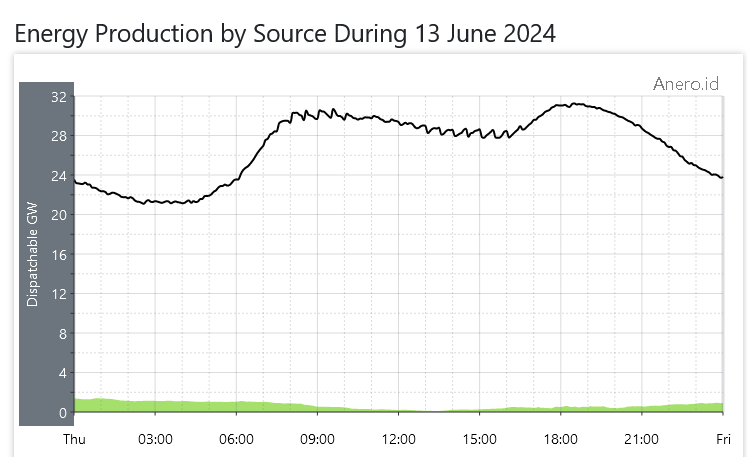

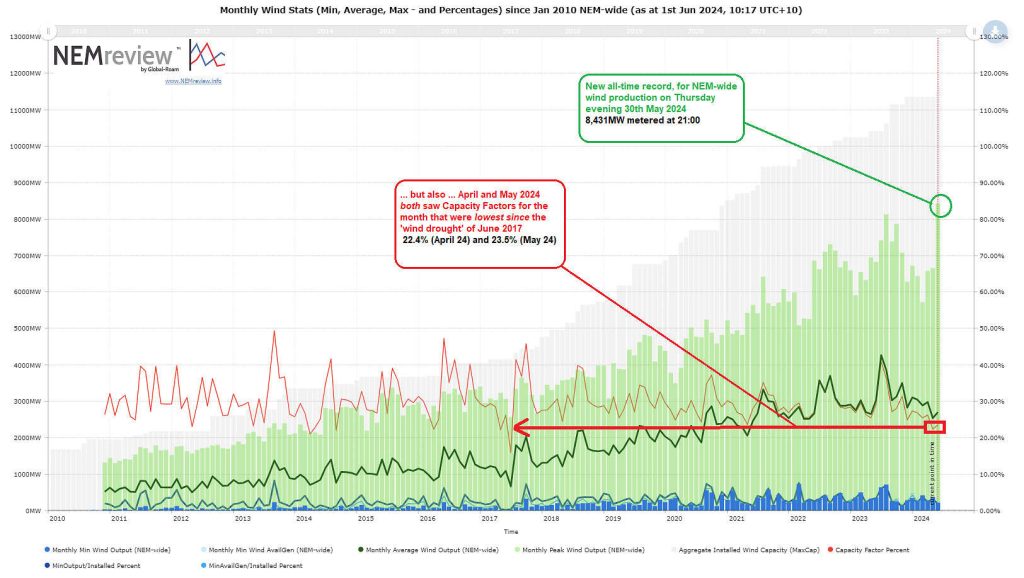





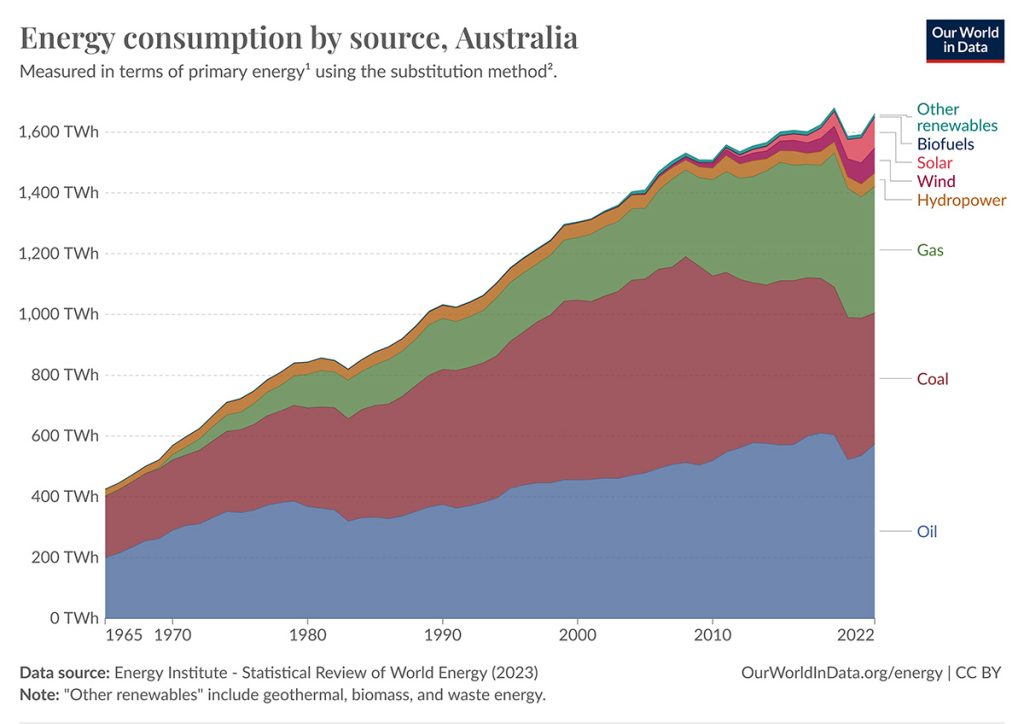


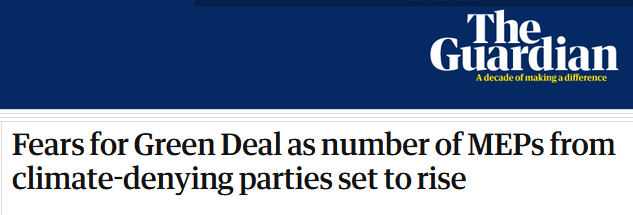

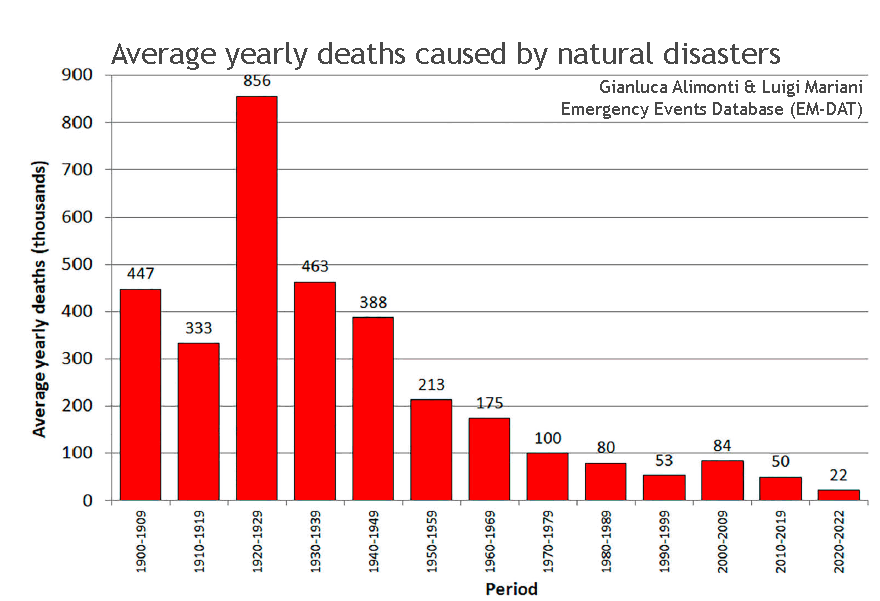
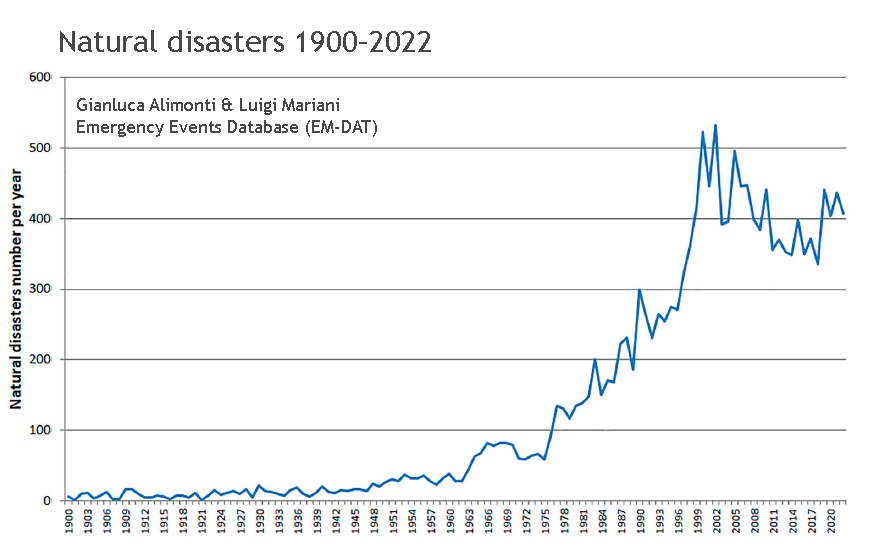
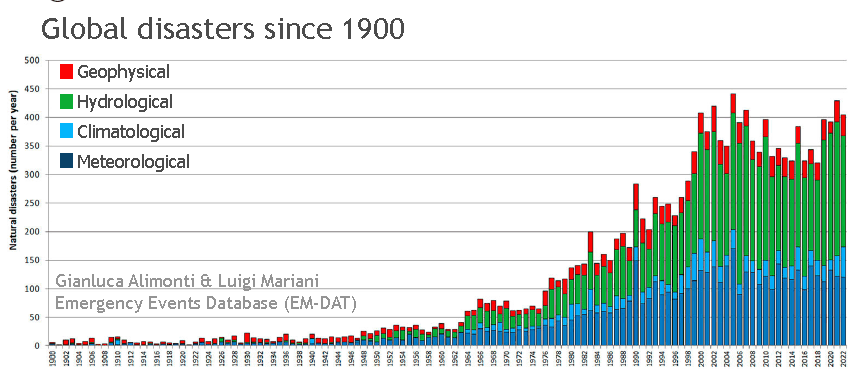












Recent Comments